![]()
![]()
![]()
Use LEFT and RIGHT arrow keys to navigate between flashcards;
Use UP and DOWN arrow keys to flip the card;
H to show hint;
A reads text to speech;
50 Cards in this Set
- Front
- Back
|
Adolf Mayer, in 1886, discovered that the tobacco mosaic disease was transmissible.
Dimitri Iwanowski, in 1892, found that filtered sap still caused tobacco mosaic disease. He called the filtered sap a contagious fluid or filterable agent. Wendell Standley, in 1935, isolated the tobacco mosaic virus. |
____, in ____, discovered that the tobacco mosaic disease was ____.
____, in ____, found that ____ still caused tobacco mosaic disease. He called the filtered sap a ____ or ____. ____, in ____, isolated the tobacco mosaic virus. |
|
|
Walter Reed, in 1901, discovered Yellow Fever.
Felix d'Herelle, in 1917, discovered bacteriophages and suggested phage therapy. In the 1930s, the the term virus was introduced and electron microscopy was invent. |
____, in ____, discovered Yellow Fever.
____, in ____, discovered bacteriophages and suggested phage ____. In the ____, the the term virus was introduced and ____ was invent. |
|
|
Viruses are obligate intracellular pathogens.
Viruses host range can be either highly specific or general. Viruses have either DNA or RNA but never both. Viruses are protected by a protein coat (capsid). The surface proteins on a virus are highly susceptible to mutations. Viruses cause synthesis of specialized structures to transfer viral particles to other cells. Outside of a host, the virus is called a virion which is a complete, fully developed, infectious viral particle. |
Viruses are ____ pathogens.
Viruses host range can be either ____ or ____. Viruses have either ____ or ____ but never both. Viruses are protected by a ____ (____). The surface proteins on a virus are highly ____ to ____. Viruses cause synthesis of ____ to transfer viral particles to other ____. Outside of a host, the virus is called a ____ which is a complete, fully ____, infectious viral ____. |
|
|
The oldest system of viral classification was based on symptomolgy.
The International Committee on Taxonomy of Viruses, in 1966, described viruses as elementary bio-systems. They classified viruses into orders, families, genera, and species. There are over 1,500 officially recognized virus species. |
The oldest system of viral classification was based on ____.
The ____, in 1966, described viruses as ____ bio-systems. They classified viruses into ____, families, ____, and species. There are over ____ officially recognized virus ____. |
|
|
Primary means of viral classification:
Nucleic acid Replication strategy Morphology of protein coat (capsid) |
Primary means of viral ____:
____ ____ ____ |
|
|
Capsid Morphology:
Helical Polyhedral |
Capsid Morphology:
____ ____ |
|
|
Viral envelopes are acquired from the host cell when budding. It is composed of phospholipids and proteins.
The envelope contains glycoproteins that are virally coded spikes and plays a role in host recognition and attachment. Spikes on the viral envelope are likely to mutate resulting in different viral strains. Viruses containing nontypical structures (accessories) are considered complex viruses. |
Viral ____ are acquired from the host cell when budding. It is composed of ____ and ____.
The ____ contains glycoproteins that are ____ spike and plays a role in host ____ and ____. Spikes on the viral ____ are likely to mutate resulting in different ____. Viruses containing ____ (accessories) are considered ____ viruses. |
|
|
Complex virus structures:
Sheath Tail fiber Pin Baseplate |
Complex virus structures:
____ ____ ____ ____ |
|
|
Viral Taxonomy:
Order - virales Family - viridae Genus - virus Species - common name / number designation |
Viral Taxonomy:
Order - ____ Family - ____ Genus - ____ Species - ____ |
|
|
In order to isolate and cultivate viruses, they must be grown in living cells.
Cytopathic effects are visible or observable effects a virus has on a cell. |
In order to ____ and ____ viruses, they must be grown in living cells.
____ are visible or observable effects a virus has on a cell. |
|
|
Animal viruses may be grown in living animals, embryonated eggs, or cell cultures.
|
Animal viruses may be grown in ____, ____, or ____.
|
|
|
Primary cell lines die after a certain number of divisions where as continuous cell lines (transformed cells) are cancer cells with no cell division control mechanisms and can continue to grow indefinitely.
|
____ die after a certain number of divisions where as ____ (transformed cells) are ____ with no cell division control mechanisms and can ____ to grow ____.
|
|
|
Virus identification:
Serological tests detect antibodies against viruses in a patient. Nucleic acids used in virus identification are RFLPs and PCR. |
Virus identification:
____ detect antibodies against viruses in a patient. Nucleic acids used in virus ____ are ____ and ____. |
|
|
Bacteriophages multiply by either the lytic cycle or the lysogenic cycle.
In the lytic cycle, phages cause lysis and death of the host cell. In the lysogenic (temperate) cycle, temperate phages incorporate DNA into the host DNA. |
Bacteriophages multiply by either the lytic cycle or the lysogenic cycle.
In the ____ cycle, phages cause lysis and ____ of the host cell. In the ____ (____) cycle, ____ phages incorporate DNA into the host DNA. |
|
|
A virus within a host is called a prophage.
|
A virus within a host is called a ____.
|
|
|
Lytic Cycle (Phage):
Attachment - tail fibers attach to host cell. Penetration - lysozyme opens the cell wall, tail sheath contracts to force the tail core and DNA into cell. Biosynthesis - production of DNA and proteins. Maturation - assembly of newly synthesized phage particles. Release - lysozymes break open the cell wall releasing the new viruses. |
____ Cycle (Phage):
Attachment - ____ attach to host cell. ____ - lysozyme opens the cell wall, ____ contracts to force the ____ and DNA into cell. Biosynthesis - production of ____ and ____. ____ - assembly of newly synthesized ____. Release - ____ break open the cell wall ____ the new viruses. |
|
|
How many new phage particles are released by lysis is called burst size.
The burst time is how long it takes for the cell to burst during the lytic cycle. The eclipse period is when there are no viruses detectable because they are all within hosts. |
How many new phage ____ are released by lysis is called ____.
The ____ is how long it takes for the cell to burst during the ____. The ____ is when there are no viruses ____ because they are all within ____. |
|
|
During the lysogenic cycle, the prophage may excise from the bacterial chromosome by another recombination event, initiating a lytic cycle.
|
During the ____ cycle, the prophage may ____ from the bacterial chromosome by another____ , initiating a lytic cycle.
|
|
|
Important results of lysogeny:
Immunity to re-infection from the same type of prophage Phage conversion due to viral DNA (viral factors, etc.) Specialized transduction |
Important results of ____ :
____ to re-infection from the same type of ____ Phage ____ due to viral DNA (____ , etc.) Specialized ____ |
|
|
Specialized transduction occurs when a phage genome excises an adjacent gene from the host. The phage then infects another cell adding the new gene to the new host giving the host new abilities.
|
____ occurs when a phage genome ____ an ____ gene from the host. The phage then ____ another cell adding the ____ gene to the new host giving the host new ____ .
|
|
|
Multiplication of Animal viruses:
Attachment - viruses attaches to cell membrane Penetration - by endocytosis or fusion Uncoating - by viral or host enzymes Biosynthesis - production of nucleic acid and proteins Maturation - nucleic acid and capsid proteins assemble Release - by budding (enveloped viruses) or rupture |
____ of Animal viruses:
Attachment - viruses attaches to ____ ____ - by endocytosis or ____ Uncoating - by ____ or ____ enzymes ____ - production of nucleic acid and ____ Maturation - ____ and ____ assemble ____ - by budding (____ viruses) or ____ |
|
|
Attachment of animal viruses:
chemical attraction no tails or tail fibers glycoprotein spikes or other attachment molecules |
____ of animal viruses:
chemical ____ no ____ or ____ ____ spikes or other attachment ____ |
|
|
Only animal viruses with envelopes undergo uncoating, naked viruses do not.
Animal DNA viruses often enter the nucleus to replicate. Animal RNA viruses often replicate in the cytoplasm. |
Only animal viruses with ____ undergo uncoating, ____ viruses do not.
Animal ____ viruses often enter the nucleus to replicate. Animal ____ viruses often replicate in the cytoplasm. |
|
|
Viral proteins are produced from positive sense RNA.
Retroviruses use reverse transcriptase to produce DNA from the viral RNA. |
Viral proteins are produced from ____ RNA.
Retroviruses use ____ to produce DNA from the viral ____. |
|
|
Once a virus has inserted its DNA into a host's DNA it is known as a provirus and is never removed or excised.
|
Once a ____ has inserted its DNA into a host's DNA it is known as a provirus and is never removed or ____.
|
|
|
Viral DNA is transported into the host cell's nucleus and integrated as a provirus where it may divide indefinitely with the host's DNA.
|
____ is transported into the host cell's nucleus and integrated as a ____ where it may divide ____ with the host's DNA.
|
|
|
Transcription of the provirus may occur, producing RNA for new retrovirus genomes and RNA that codes for that retrovirus capsid and envelope proteins.
|
____ of the provirus may occur, producing RNA for new ____ genomes and RNA that codes for that retrovirus capsid and ____.
|
|
|
In RNA positive-sense strand viruses, viral RNA functions as a template for synthesis of RNA polymerase which copies negative-sense strand RNA to make mRNA in cytoplasm.
In RNA negative-sense strand viruses, viral enzymes copy viral RNA to make mRNA in cytoplasm. In RNA double stranded viruses, viral enzymes copy negative-sense strand RNA to make mRNA in cytoplasm. |
In RNA ____ strand viruses, viral RNA functions as a template for synthesis of ____ which copies ____ strand RNA to make mRNA in cytoplasm.
In RNA ____ strand viruses, viral enzymes copy viral ____ to make mRNA in ____. In RNA ____ stranded viruses, viral enzymes copy negative-sense strand RNA to make ____ in cytoplasm. |
|
|
Most DNA viruses assemble in and are released from nucleus into cytosol.
Most RNA viruses develop solely in the cytoplasm. |
Most DNA viruses ____ in and are released from nucleus into ____.
Most ____ viruses develop solely in the ____. |
|
|
Enveloped viruses cause persistent infections.
Viruses that release through budding have a slow release time. Naked viruses are released by exocytosis or may cause lysis and death of host cell. |
Enveloped viruses cause ____ infections.
Viruses that release through ____ have a slow release time. ____ viruses are released by exocytosis or may cause ____ and ____ of host cell. |
|
|
Bacteriophages attach using tail fibers to cell wall proteins while animal viruses attachment sites are plasma membrane proteins and glycoproteins.
Bacteriophages inject their DNA into the host cell while animal viruses capsid enter by endocytosis or fusion. Bacteriophages do not undergo uncoating but animal viruses uncoating is done by enzymatic removal of capsid proteins. Bacteriophages biosynthesis is done in the cytoplasm while animal viruses in undergo biosynthesis in the nucleus for DNA viruses and cytoplasm for RNA viruses. Bacteriophages cause chronic infection by lysogeny while animal viruses cause chronic infection by latency, slow viral infections, and cancer. Bacteriophages are released by host cell lysis while animal viruses are released by budding if they have an envelope and non-enveloped viruses rupture the plasma membrane. |
Bacteriophages attach using ____ to cell wall proteins while ____ attachment sites are ____ and ____.
Bacteriophages ____ their DNA into the host cell while animal viruses capsid enter by ____ or ____. Bacteriophages do not undergo ____ but animal viruses ____ is done by enzymatic removal of ____. Bacteriophages biosynthesis is done in the ____ while animal viruses in undergo biosynthesis in the ____ for DNA viruses and ____ for RNA viruses. Bacteriophages cause chronic infection by ____ while animal viruses cause chronic infection by ____, slow ____, and ____ . Bacteriophages are released by ____ while animal viruses are released by ____ if they have an envelope and non-enveloped viruses rupture the ____. |
|
|
Oncogenes transform or mutate normal cells into tumor cells.
Oncogenes cause increased growth and loss of contact inhibition. Oncogenes tend to be misshaped and exhibit chromosomal abnormalities. Oncogenes are activated by: mutagenic chemicals radiation viruses Some viruses can bring their own oncogenes to a cell. |
____ transform or mutate normal cells into ____ cells.
____ cause increased ____ and loss of contact ____. ____ tend to be misshaped and exhibit ____. ____ are activated by: ____ ____ ____ Some viruses can bring their own ____ to a cell. |
|
|
Protooncogenes are cells that force cellular division while tumor suppressor genes stop cellular division.
|
____ are cells that force cellular division while ____ stop cellular division.
|
|
|
Oncoviruses are viral DNA integrated into the hosts DNA and induce tumors.
RNA viruses cannot be oncoviruses unless it is a retrovirus. |
____ are viral DNA integrated into the hosts ____ and induce ____.
____ viruses cannot be ____ unless it is a retrovirus. |
|
|
Latent viral infections can remain dormant in asymptomatic host cells for long periods. Examples are cold sores and shingles.
Persistent viral infections cause diseases that progress slowly over a long period of time and are generally fatal. An example is the measles virus. |
____ infections can remain dormant in ____ host cells for long periods. Examples are ____ and ____.
____ infections cause diseases that progress ____ over a long period of time and are generally ____. An example is the ____. |
|
|
Plant viruses can only enter through wounds or via insect bites.
Once infected a plant virus may be transmitted in pollen. |
____ can only enter through wounds or via ____.
Once infected a ____ may be transmitted in ____. |
|
|
Viroids, which can cause infectious disease in plants and animals, are naked RNA.
|
____, which can cause infectious disease in ____ and animals, are ____ RNA.
|
|
|
Spongiform encephalopathies, an inflammation of neurons, is caused by prions.
Sheep scrapie Creutzfeldt-Jakob disease Gerstmann-Straussler-Scheinker disease fatal familial insomia mad cow disease |
____ , an inflammation of neurons, is caused by prions.
____ ____ disease ____ disease ____ insomia ____ disease |
|
|
Prions are proteinaceous infectious particle and cause inherited and transmissible diseases.
Prions are incorrectly folded proteins. Inherited prions are proteins that have beta pleated sheets instead of alpha helixes. Infectious prions force proteins to refold incorrectly. |
Prions are ____ infectious particle and cause ____ and ____ diseases.
Prions are incorrectly ____ proteins. Inherited prions are proteins that have ____ instead of ____. ____ prions force proteins to refold ____. |
|
|
.
|

|
|
|
.
|
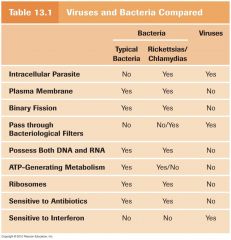
|
|
|
.
|
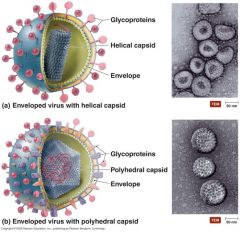
|
|
|
.
|
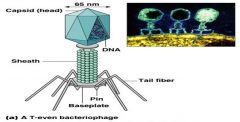
|
|
|
.
|
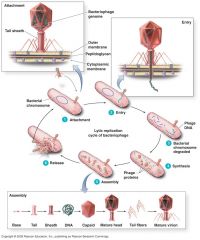
|
|
|
.
|
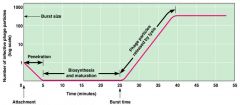
|
|
|
.
|

|
|
|
.
|
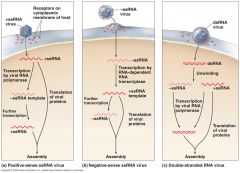
|
|
|
.
|
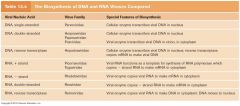
|
|
|
.
|

|
|
|
.
|
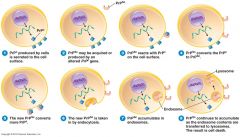
|

